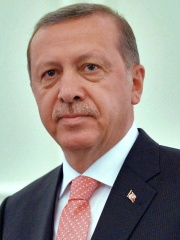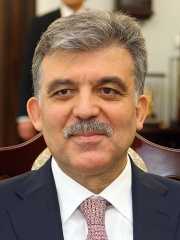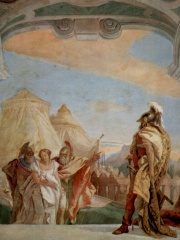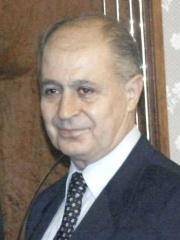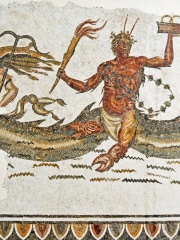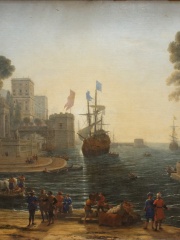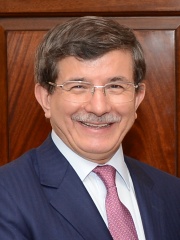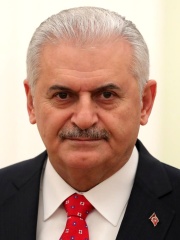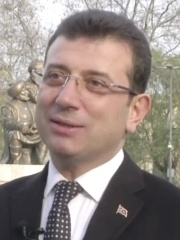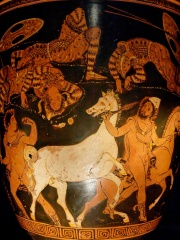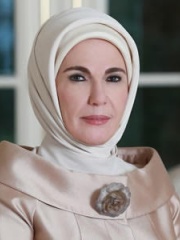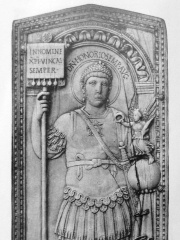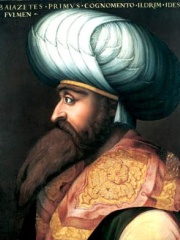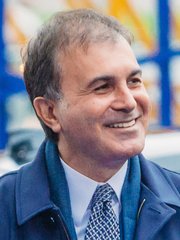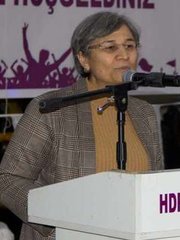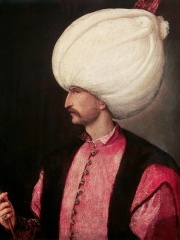
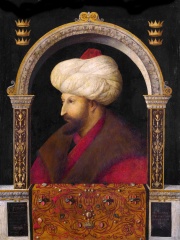
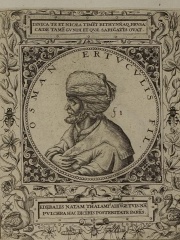
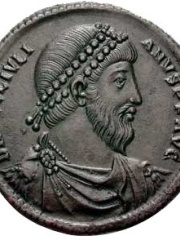
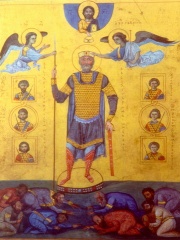
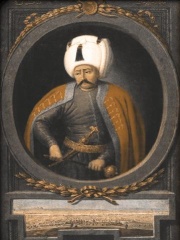
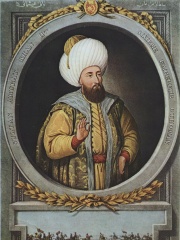
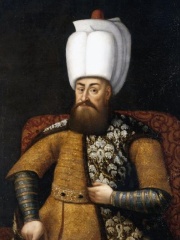
The Most Famous
POLITICIANS from Türkiye
This page contains a list of the greatest Turkish Politicians. The pantheon dataset contains 19,576 Politicians, 516 of which were born in Türkiye. This makes Türkiye the birth place of the 8th most number of Politicians behind Russia, and Spain.
Top 10
The following people are considered by Pantheon to be the top 10 most legendary Turkish Politicians of all time. This list of famous Turkish Politicians is sorted by HPI (Historical Popularity Index), a metric that aggregates information on a biography's online popularity. Visit the rankings page to view the entire list of Turkish Politicians.

1. Suleiman the Magnificent (1494 - 1566)
With an HPI of 91.58, Suleiman the Magnificent is the most famous Turkish Politician. His biography has been translated into 131 different languages on wikipedia.
Suleiman I (Ottoman Turkish: سلیمان اول, romanized: Süleymân-ı Evvel; Modern Turkish: I. Süleyman, IPA: [biɾinˈdʒi sylejˈman]; 6 November 1494 – 6 September 1566), commonly known as Suleiman the Magnificent in the Western world and as Suleiman the Lawgiver (قانونی سلطان سلیمان, Ḳânûnî Sulṭân Süleymân) in his own realm, was the Ottoman sultan between 1520 and his death in 1566. Under his administration, the Ottoman Empire ruled over at least 25 million people. After succeeding his father Selim I on 30 September 1520, Suleiman began his reign by launching military campaigns against the Christian powers of Central and Eastern Europe and the Mediterranean; Belgrade fell to him in 1521 and Rhodes in 1522–1523, and at Mohács in 1526, Suleiman broke the strength of the Kingdom of Hungary. Hungary was subsequently divided, with much of it incorporated directly into the empire. However, his defeat at the siege of Vienna in 1529 checked advances further into Europe. Presiding over the apex of the Ottoman Empire's economic, military, and political strength, Suleiman rose to become a prominent monarch of the 16th century, as he personally led Ottoman armies in their conquests of a number of European Christian strongholds. He also fought for years against the Shia Muslim Safavid Empire of Persia, resulting in the annexation of Mesopotamia. Ottoman Tripolitania was established in North Africa. The Ottoman fleet dominated the seas from the Mediterranean to the Red Sea and through the Persian Gulf. At the helm of the rapidly expanding Ottoman Empire, Suleiman personally instituted major judicial changes relating to society, education, taxation, and criminal law. His reforms, carried out in conjunction with the Ottoman chief judicial official Ebussuud Efendi, harmonized the relationship between the two forms of Ottoman law: sultanic (Kanun) and Islamic (Sharia). He was a distinguished poet and goldsmith; he also became a great patron of fine culture, overseeing the "Golden Age" of the Ottoman Empire in its artistic, literary, and architectural development. In 1533, Suleiman broke with Ottoman tradition by marrying Roxelana (Ukrainian: Роксолана), a woman from his Imperial Harem. Roxelana, so named in Western Europe for her red hair, was a Ruthenian who converted to Sunni Islam from Eastern Orthodox Christianity and thereafter became one of the most influential figures of the "Sultanate of Women" period in the Ottoman Empire. Upon Suleiman's death in 1566, which ended his 46-year-long reign, he was succeeded by his and Roxelana's son Selim II. Suleiman's other potential heirs, Mehmed and Mustafa, had died; Mehmed had succumbed to smallpox in 1543, while Mustafa had been executed via strangling on Suleiman's orders in 1553. His other son Bayezid was also executed on his orders, along with Bayezid's four sons, after a rebellion in 1561. Although scholars typically regarded the period after his death to be one of crisis and adaptation rather than of simple decline, the end of Suleiman's reign was a watershed in Ottoman history. In the decades after Suleiman, the Ottoman Empire began to experience significant political, institutional, and economic changes—a phenomenon often referred to as the Era of Transformation.

2. Mehmed the Conqueror (1432 - 1481)
With an HPI of 89.49, Mehmed the Conqueror is the 2nd most famous Turkish Politician. His biography has been translated into 106 different languages.
Mehmed II (Ottoman Turkish: محمد ثانى, romanized: Meḥemmed-i s̱ānī; Turkish: II. Mehmed, pronounced [icinˈdʒi ˈmehmet]; 30 March 1432 – 3 May 1481), commonly known as Mehmed the Conqueror (Ottoman Turkish: ابو الفتح, romanized: Ebū'l-fetḥ, lit. 'the Father of Conquest'; Turkish: Fâtih Sultan Mehmed), was twice the sultan of the Ottoman Empire from August 1444 to September 1446 and then later from February 1451 to May 1481. In Mehmed II's first reign, he defeated the crusade led by John Hunyadi after the Hungarian incursions into his country broke the conditions of the truce per the Treaties of Edirne and Szeged. When Mehmed II ascended the throne again in 1451, he strengthened the Ottoman Navy and made preparations to attack Constantinople. At the age of 21, he conquered Constantinople and brought an end to the Byzantine Empire. After the conquest, Mehmed claimed the title caesar of Rome (Ottoman Turkish: قیصر روم, romanized: qayṣar-i rūm), based on the fact that Constantinople had been the seat and capital of the surviving Eastern Roman Empire since its consecration in 330 AD by Emperor Constantine I. The claim was soon recognized by the Patriarchate of Constantinople, albeit not by most European monarchs. Mehmed continued his conquests in Anatolia with its reunification and in Southeast Europe as far west as Bosnia. At home, he made many political and social reforms. He encouraged the arts and sciences, and by the end of his reign, his rebuilding program had changed Constantinople into a thriving imperial capital. He is considered a hero in modern-day Turkey and parts of the wider Muslim world. Among other things, Istanbul's Fatih district, Fatih Sultan Mehmet Bridge and Fatih Mosque are named after him.

3. Osman I (1254 - 1327)
With an HPI of 87.41, Osman I is the 3rd most famous Turkish Politician. His biography has been translated into 97 different languages.
Osman I or as he is known, Osman Gazi or Osman Bey.(Ottoman Turkish: عثمان غازى , عثمان بك, romanized: ʿOsmān Ġāzī; Turkish: I. Osman or Osman Gazi; died 1323/4) was the eponymous founder of the Ottoman Empire (first known as a beylik or emirate). While initially a small Turkoman principality during Osman's lifetime, his beylik transformed into a vast empire in the centuries after his death. It existed until 1922 shortly after the end of World War I, when the sultanate was abolished. Owing to the scarcity of historical sources dating from his lifetime, very little factual information about Osman has survived. Not a single written source survives from Osman's reign, and the Ottomans did not record the history of his life until the fifteenth century, more than a hundred years after his death. Because of this, historians find it very challenging to differentiate between fact and myth in the many stories told about him. One historian has even gone so far as to declare it impossible, describing the period of Osman's life as a "black hole". According to later Ottoman tradition, Osman's ancestors were descendants of the Kayı tribe of Oghuz Turks. However, many scholars of the early Ottomans regard it as a later fabrication meant to reinforce dynastic legitimacy. The Ottoman principality was one of many Anatolian beyliks that emerged in the second half of the thirteenth century. Situated in the region of Bithynia in the north of Asia Minor, Osman's principality found itself particularly well placed to launch attacks on the vulnerable Byzantine Empire, which his descendants would eventually go on to conquer.

4. Julian (331 - 363)
With an HPI of 85.95, Julian is the 4th most famous Turkish Politician. His biography has been translated into 81 different languages.
Julian (Latin: Flavius Claudius Julianus; Ancient Greek: Ἰουλιανός Ioulianos; 331 – 26 June 363) was the Caesar of the West from 355 to 360 and Roman emperor from 361 to 363, as well as a notable philosopher and author in Greek. His rejection of Christianity, and his promotion of Neoplatonic Hellenism and persecution of Christians, caused him to be remembered as Julian the Apostate in the Christian tradition. A nephew of Constantine the Great, Julian was one of few in the imperial family to survive the purges and civil wars during the reign of Constantius II, his cousin. Julian became an orphan as a child after his father was executed in 337, and spent much of his life under Constantius's close supervision. However, the emperor allowed Julian freedom to pursue an education in the Greek-speaking east. In 355, Constantius II summoned Julian to court and appointed him to rule Gaul. Julian was successful in his rule, defeating and counterattacking Germanic raids across the Rhine and encouraging the provinces' return to prosperity. In 360, he was proclaimed emperor by his soldiers at Lutetia (Paris), sparking a civil war with Constantius. However, Constantius died before the two could face each other in battle, having named Julian as his successor to prevent further bloodshed. In 363, Julian embarked on an ambitious campaign against the Sasanian Empire. The campaign was initially successful, securing a victory outside Ctesiphon in Mesopotamia. However, he did not attempt to besiege the capital. Julian instead moved into Persia's heartland, but he soon faced supply problems and was forced to retreat northwards while being ceaselessly harassed by Persian skirmishers. During the Battle of Samarra, Julian was mortally wounded. He was succeeded by Jovian, a senior officer in the imperial guard, who was obliged to cede territory, including Nisibis, in order to save the trapped Roman forces. Julian and Jovian were the last sole emperors to rule the whole Empire for their entire reign, after which it was permanently divided between a Western and Eastern court. Julian was the last non-Christian ruler of the Roman Empire, and he believed that it was necessary to restore the Empire's ancient Roman values and traditions in order to save it from dissolution. He purged the top-heavy state bureaucracy, and attempted to revive traditional Roman religious practices at the expense of Christianity. His efforts to build a Third Temple in Jerusalem were probably intended to harm Christianity rather than please Jews. Julian also forbade Christians from teaching and learning classical texts.
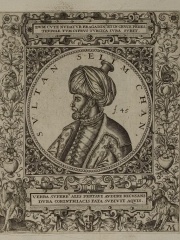
5. Selim II (1524 - 1574)
With an HPI of 85.83, Selim II is the 5th most famous Turkish Politician. His biography has been translated into 75 different languages.
Selim II (Ottoman Turkish: سليم ثانى, romanized: Selīm-i sānī; Turkish: II. Selim; 28 May 1524 – 15 December 1574), also known as Selim the Blond (Turkish: Sarı Selim) or Selim the Drunkard (Sarhoş Selim), was the sultan of the Ottoman Empire from 1566 until his death in 1574. He was a son of Suleiman the Magnificent and his wife Hurrem Sultan. Selim had been an unlikely candidate for the throne until his brother Mehmed died of smallpox, his half-brother Mustafa was strangled to death by the order of his father and his brother Bayezid was killed on the order of his father after a rebellion against him and Selim. During his reign, his grand vizier Sokollu Mehmed Pasha exerted significant control over state governance. The conquest of Cyprus and Tunis were notable achievements during his reign but setbacks occurred in the Battle of Lepanto and the failed capture of Astrakhan as part of the war with Russia.

6. Basil II (958 - 1025)
With an HPI of 85.33, Basil II is the 6th most famous Turkish Politician. His biography has been translated into 66 different languages.
Basil II Porphyrogenitus (Greek: Βασίλειος Πορφυρογέννητος, romanized: Basíleios Porphyrogénnētos; 958 – 15 December 1025), nicknamed the Bulgar Slayer (Greek: ὁ Βουλγαροκτόνος, ho Boulgaroktónos, Bulgarian: Българоубиец), was the senior Byzantine emperor from 976 to 1025. He and his brother Constantine VIII were crowned before their father Romanos II died in 963, but they were too young to rule. The throne thus went to two generals, Nikephoros Phokas (r. 963–969) and John Tzimiskes (r. 969–976) before Basil became senior emperor, though his influential great-uncle Basil Lekapenos remained as the de facto ruler until 985. His reign of 49 years and 11 months was the longest of any Roman emperor. The early years of Basil's reign were dominated by civil wars against two powerful generals from the Byzantine Anatolian aristocracy: first Bardas Skleros and later Bardas Phokas, which ended shortly after Phokas' death and Skleros' submission in 989. Basil then oversaw the stabilization and expansion of the eastern frontier of the Byzantine Empire and the complete subjugation of the First Bulgarian Empire, its foremost European foe, after a long struggle. Although the Byzantines had made a truce with the Fatimid Caliphate in 987–988, Basil led a campaign against the Caliphate that ended with another truce in 1000. He also conducted a campaign against the Khazar Khaganate that gained the Byzantine Empire part of Crimea and a series of successful campaigns against the Kingdom of Georgia. Despite near-constant warfare, Basil distinguished himself as an administrator, reducing the power of the great land-owning families who dominated the Empire's administration and military, filling its treasury, and leaving it with its greatest expanse in four centuries. Although his successors were largely incapable rulers, the Empire flourished for decades after Basil's death. One of the most important decisions taken during his reign was to offer the hand of his sister Anna Porphyrogenita to Vladimir I of Kiev in exchange for military support, thus forming the Byzantine military unit known as the Varangian Guard. The marriage of Anna and Vladimir led to the Christianization of the Kievan Rus' and the incorporation of later successor states of Kievan Rus' within the Byzantine cultural and religious tradition. Basil is seen as a Greek national hero but is a despised figure among Bulgarians.

7. Selim I (1470 - 1520)
With an HPI of 85.13, Selim I is the 7th most famous Turkish Politician. His biography has been translated into 81 different languages.
Selim I (Ottoman Turkish: سليم الأول; Turkish: I. Selim; 10 October 1470 – 22 September 1520), also known as Selim the Grim or Selim the Resolute (Turkish: Yavuz Sultan Selim), was the sultan of the Ottoman Empire from 1512 to 1520. Despite lasting only eight years, his reign is notable for the enormous expansion of the Empire, particularly his conquest between 1516 and 1517 of the entire Mamluk Sultanate of Egypt, which included all of the Levant, Hejaz, Tihamah and Egypt itself. On the eve of his death in 1520, the Ottoman Empire spanned about 3.4 million km2 (1.3 million sq mi), having grown by seventy percent during Selim's reign. Selim's conquest of the Middle Eastern heartlands of the Muslim world, and particularly his assumption of the role of guardian of the pilgrimage routes to Mecca and Medina, established the Ottoman Empire as the pre-eminent Muslim state. His conquests dramatically shifted the empire's geographical and cultural center of gravity away from the Balkans and toward the Middle East. By the eighteenth century, Selim's conquest of the Mamluk Sultanate had come to be romanticized as the moment when the Ottomans seized leadership over the rest of the Muslim world, and consequently Selim is popularly remembered as the first legitimate Ottoman Caliph, although stories of an official transfer of the caliphal office from the Mamluk Abbasid dynasty to the Ottomans were a later invention.

8. Murad II (1404 - 1451)
With an HPI of 84.67, Murad II is the 8th most famous Turkish Politician. His biography has been translated into 74 different languages.
Murad II (Ottoman Turkish: مراد ثانى, romanized: Murād-ı sānī, Turkish: II. Murad; June 1404 – 3 February 1451) was twice the sultan of the Ottoman Empire, from 1421 to 1444 and from 1446 to 1451.

9. Murad III (1546 - 1595)
With an HPI of 84.29, Murad III is the 9th most famous Turkish Politician. His biography has been translated into 74 different languages.
Murad III (Ottoman Turkish: مراد ثالث, romanized: Murād-i sālis; Turkish: III. Murad; 4 July 1546 – 16 January 1595) was the sultan of the Ottoman Empire from 1574 until his death in 1595. His rule saw battles with the Habsburgs and exhausting wars with the Safavids. The long-independent Morocco was for a time made a vassal of the empire but regained independence in 1582. His reign also saw the empire's expanding influence on the eastern coast of Africa. However, the empire was beset by increasing corruption and inflation from the New World which led to unrest among the Janissary and commoners. Relations with Elizabethan England were cemented during his reign, as both had a common enemy in the Spanish. He was also a great patron of the arts, commissioning the Siyer-i-Nebi and other illustrated manuscripts.
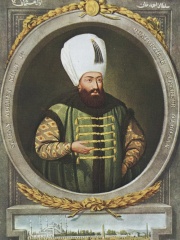
10. Ahmed I (1590 - 1617)
With an HPI of 84.23, Ahmed I is the 10th most famous Turkish Politician. His biography has been translated into 72 different languages.
Ahmed I (Ottoman Turkish: احمد اول Aḥmed-i evvel; Turkish: I. Ahmed; 18 April 1590 – 22 November 1617) was the sultan of the Ottoman Empire from 1603 to 1617. Ahmed's reign is noteworthy for marking the first breach in the Ottoman tradition of royal fratricide; henceforth, Ottoman rulers would no longer systematically execute their brothers upon accession to the throne. He is also well known for his construction of the Blue Mosque, one of the most famous mosques in Turkey.
People
Pantheon has 522 people classified as Turkish politicians born between 1800 BC and 1993. Of these 522, 54 (10.34%) of them are still alive today. The most famous living Turkish politicians include Recep Tayyip Erdoğan, Abdullah Gül, and Briseis. The most famous deceased Turkish politicians include Suleiman the Magnificent, Mehmed the Conqueror, and Osman I. As of April 2024, 10 new Turkish politicians have been added to Pantheon including İbrahim Kalın, Ali Yerlikaya, and Gültan Kışanak.
Living Turkish Politicians
Go to all RankingsRecep Tayyip Erdoğan
1954 - Present
HPI: 83.60
Abdullah Gül
1950 - Present
HPI: 75.95
Briseis
HPI: 72.53
Ahmet Necdet Sezer
1941 - Present
HPI: 72.15
Phorcys
HPI: 71.45
Kemal Kılıçdaroğlu
1948 - Present
HPI: 70.77
Chryseis
HPI: 69.16
Ahmet Davutoğlu
1959 - Present
HPI: 68.40
Binali Yıldırım
1955 - Present
HPI: 67.98
Ekrem İmamoğlu
1970 - Present
HPI: 67.69
Rhesus of Thrace
HPI: 67.46
Emine Erdoğan
1955 - Present
HPI: 66.70
Deceased Turkish Politicians
Go to all RankingsSuleiman the Magnificent
1494 - 1566
HPI: 91.58
Mehmed the Conqueror
1432 - 1481
HPI: 89.49
Osman I
1254 - 1327
HPI: 87.41
Julian
331 - 363
HPI: 85.95
Selim II
1524 - 1574
HPI: 85.83
Basil II
958 - 1025
HPI: 85.33
Selim I
1470 - 1520
HPI: 85.13
Murad II
1404 - 1451
HPI: 84.67
Murad III
1546 - 1595
HPI: 84.29
Ahmed I
1590 - 1617
HPI: 84.23
Honorius
384 - 423
HPI: 83.72
Bayezid I
1354 - 1403
HPI: 83.62
Newly Added Turkish Politicians (2025)
Go to all Rankingsİbrahim Kalın
1971 - Present
HPI: 49.98
Ali Yerlikaya
HPI: 46.94
Gültan Kışanak
1961 - Present
HPI: 46.35
Ömer Çelik
1968 - Present
HPI: 46.33
Fahrettin Koca
1965 - Present
HPI: 46.04
Leyla Güven
1964 - Present
HPI: 45.27
Garo Paylan
1972 - Present
HPI: 42.63
Ekin Deligöz
1971 - Present
HPI: 42.15
Dilek Öcalan
1987 - Present
HPI: 41.30
Doğuş Balbay
1989 - Present
HPI: 35.59
Overlapping Lives
Which Politicians were alive at the same time? This visualization shows the lifespans of the 25 most globally memorable Politicians since 1700.

